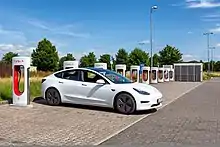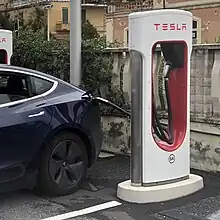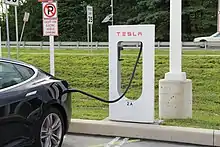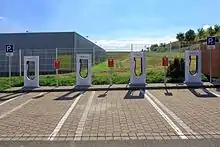
Tesla Supercharger is a high-voltage direct current (DC) fast-charging network built by American vehicle manufacturer Tesla, Inc. for electric cars.
The Supercharger network was introduced on September 24, 2012, as the Tesla Model S entered production, with six sites in California, Nevada, and Arizona. As of January 2024, Tesla operates a network of 6,000 Supercharger stations with over 50,000 connectors. The stations are primarily deployed in three regions: Asia Pacific (over 2,400), North America (over 2,300), and Europe (over 1,100). Superchargers supply electric power at between 72 kilowatts (kW) and 250 kW, with the maximum amount increasing over the years as the company improves its technology.
Usage is typically billed by the energy consumed during charging. Idle fees can be charged to customers who remain plugged in after charging has been completed to discourage loitering.
Technology

Tesla typically places Superchargers near major highways at locations with amenities for drivers, such as restrooms, restaurants, and shopping.[1] Some sites also have solar canopies and Megapacks[2] installed by Tesla Energy to offset energy use and provide drivers with protection from the elements.[3]

The original V1 and V2 Tesla supercharging stations were built with a single charger equipment cabinet shared between two charge posts. Because of this arrangement, if two cars are connected, and both request the maximum power available (100 kW for V1 and 150 kW for V2), the charger will only deliver half the maximum power.[4]
As an alternative to the Supercharger, in 2015, Tesla briefly implemented a battery swapping station at Harris Ranch in California. The Tesla battery station performed few swaps, with most Tesla owners preferring to recharge their vehicles' batteries instead.[5]
"Urban" Supercharger posts were introduced in September 2017. These more compact posts have a maximum power delivery of 72 kW but do not share equipment with other posts, allowing the maximum power to be delivered. These more compact posts are primarily deployed in urban areas such as shopping malls, parking lots, and garages.[6][7]
V3 stations were introduced in 2019 and could deliver up to 250 kW. For V3 stations, four posts share a 1,000 kW charger equipment cabinet, allowing each to deliver the maximum power regardless of nearby charging sessions.[8] The V3 charge posts use a liquid-cooled cable which allows the cable to be thinner and lighter while delivering more power.[9][10]
Tesla introduced mobile Supercharger stations in 2019 with several urban supercharger posts and a Tesla Megapack energy storage system mounted on a semi-trailer truck. These stations provide temporary stations for nearby events, expand capacity during peak travel seasons, or can be deployed when a station needs to be taken offline. The Megapack can charge up to 100 vehicles before being depleted.[11]
V4 stations began to roll out in early 2023 and have longer cables for charging vehicles from other automakers.[12] They are also capable of supporting up to 615 kW of power delivery; however, they are currently software limited to 250 kW.[12][13]
Connectors and interoperability
Tesla began installing a "Magic Dock" at some locations in February 2023.[14] The dock holds a NACS to CCS adapter. When a NACS-equipped vehicle driver uses the charger, they remove the NACS connector from the docked adapter. When a CCS-equipped vehicle driver reserves a charger via the Tesla mobile app, the Magic Dock releases the NACS to CCS adapter. The "magic" is that the adapter always remains captive – either locked in the dock on the charger (when the NACS connector is available to be used) or locked onto the NACS connector (when the CCS adapter is available to be used).[15] The "Magic Dock" will allow Tesla to share in the $7.5 billion U.S. federal government incentives to build out CCS-equipped charging infrastructure.[16]

In November 2018, under pressure from European regulators, Tesla announced that it would begin using the CCS2 charging standard, adding the inlets to new vehicles, offering adapters to existing vehicle owners and adding CCS2 connectors to Superchargers.[17][18][19]
In China, Tesla equips its vehicles and Superchargers with the GB/T charging standard (an abbreviation of "GuoBiao/TuiJian", translated as "recommended national standard").[20]
Network
The average number of Tesla cars per Supercharger stall was 34 in 2016.[21][22] As of September 2023, Tesla bids building its chargers at about half the cost of its competitors.[23] Cost estimates per station range from US$100,000 in 2013[24] to US$270,000 in 2015, depending on the number of stalls and other circumstances.[25] Tesla estimates that station equipment lasts 12 years.[26]
Most car charging occurs at home or work, a situation that Tesla has compared to cell phone charging.[27] As of 2014, less than 10% of charging came from Superchargers.[28]
For 2021, Tesla states the network had 99.96% uptime (at least 50% daily capacity) and its power was 100% renewable (through solar power on-site and through purchasing electricity which was matched to renewable generation.)[29][30][31]
Costs
Unlimited supercharging for life is free for all Model S and Model X cars that were ordered before January 15, 2017,[32] or between August 2, 2019[33] and May 26, 2020,[34] or for vehicles that were purchased using a referral code during specific periods.[35]
Model S and Model X cars that were ordered between January 15, 2017, and November 2, 2018, received 400 kWh (about 1,000 miles or 1,600 km) of free Supercharging credits per year.[36] Once those credits are used, supercharging has a fee.[37]
Other than the above situations, Tesla Model S and Model X cars purchased between November 2, 2018, and August 2, 2019, and all Model 3 and Model Y cars purchased at any time do not receive supercharging credits.[33] Any charges are automatically billed to the Tesla account the car is associated with or to the credit card on file for that account.
Deployment
As of January 2024, Tesla operates a network of 6,000 Supercharger stations with over 50,000 connectors The network is primarily deployed in three regions: Asia Pacific (over 2,400 stations), North America (over 2,300), and Europe (over 1,100).[38]
| Year | Stations | Annual growth | Connectors | Annual growth | Source |
|---|---|---|---|---|---|
| 2012 | 7 | — | — | — | [39] |
| 2013 | 63 | 800% | — | — | [40] |
| 2014 | 380 | 503% | — | — | [41] |
| 2015 | 584 | 54% | — | — | [42] |
| 2016 | 790 | 35% | — | — | [43] |
| 2017 | 1,128 | 43% | — | — | [44] |
| 2018 | 1,421 | 26% | 12,002 | — | [45] |
| 2019 | 1,821 | 28% | 16,104 | 34% | [46] |
| 2020 | 2,564 | 41% | 23,277 | 45% | [47] |
| 2021 | 3,476 | 36% | 31,498 | 35% | [48] |
| 2022 | 4,678 | 35% | 42,419 | 35% | [49] |
North America

.jpg.webp)
The first Superchargers in the world opened in 2012 in the United States. Six stations were deployed along Interstate 5 in California, enabling trips from Los Angeles and San Francisco, and two stations deployed along Interstate 95, enabling trips between Boston and Washington DC.[50][51] By mid-July 2013, 15 stations were open across the United States.[52] The stations were developed and mass constructed in cooperation with Black & Veatch.[53]
Supercharging stations were available in Canada along Ontario Highway 401 and Quebec Autoroute 20 corridor between Toronto and Montreal by 2014.[54]
The initial network was built in high-traffic corridors across North America, followed by networks in Europe and Asia in the second half of 2013. The first Supercharger corridor in the US opened with free access in October 2012. This corridor included six stations placed along routes connecting San Francisco, Lake Tahoe, Los Angeles, and Las Vegas.[55][56] A second corridor was opened in December 2012 along the Northeast megalopolis, connecting Washington, DC, Baltimore, Philadelphia, New York City and Boston. This corridor includes three stations in highway rest areas, one in Delaware and two adjacent ones in Connecticut.[57]
According to Musk, "...we expect all of the United States to be covered by the end of next year [2013]". He also said that early Tesla owners' use of the network would be free forever.[58]
Europe

In early 2015, the first European Supercharger was upgraded with a 'solar canopy' (a carport with solar cells on the roof) in Køge, Denmark.[59] According to the person responsible for Tesla's Superchargers in the Nordic countries, Christian Marcus, the 12-stall Supercharger in Køge has 300 m2 (3,230 sq ft) solar cells with a projected annual production of about 40 MWh and is equipped with its own battery bank for temporary storage of excess production. Unlike most other European Supercharger stations, Tesla has bought the land on which the Køge Supercharger stands.[60] On April 26, 2016, Kostomłoty became the first charger to open in Poland.[61] Tesla opened a grid-connected 2-stall Supercharger at Nürburgring in 2019.[62] There are a few privately operated Supercharger stations such as the one opened on April 27, 2016, in Zarechye, Russia, with 3 stalls.[63]
In 2015, the European Supercharger network was planned to allow a Model S to drive from the North Cape (near Honningsvåg) in Norway to Istanbul or Lisbon.[60] As of August 2023, there are Supercharger stations in or near both Istanbul[64] and Lisbon.[65] The map of current and planned sites[66] includes every European Union country except Malta and Cyprus, and represents all of the countries in the world in the top 10 of electric vehicle adoption rates.[67]
Asia-Pacific
Superchargers operate in China, where Shanghai has 1,000 chargers at 100 locations in late 2021, Beijing has 800, and Tibet is accessible.[68] Superchargers are also available in Hong Kong and Macau.
Australia,[69] Japan, Malaysia, New Zealand, Singapore, South Korea, Taiwan and Thailand also have Superchargers.[70]
Middle East
Superchargers are available in Israel, Jordan and the United Arab Emirates. Qatar will have its first Superchargers by the end of Q1 2024.[71]
Megacharger
In November 2017, Tesla announced a higher-capacity Megacharger as part of the unveiling of a prototype for its Tesla Semi, a semi-trailer truck. These Megachargers provide 400 miles (644 km) of charge in 30 minutes to the Tesla Semis.[72][73]
In November 2021, the first Megacharger was installed at the Gigafactory Nevada where the Tesla Semi is built.[74] A second Megacharger was permitted for construction at a PepsiCo facility in Modesto, California, in late 2021.[75]
The megawatt-class cable for the Megacharger supports three times the current density of the V3 Supercharger —35 amperes/mm2 versus approximately 12 for the V3. The cable will also be liquid-cooled to support 1000-amp charge rates at 1000 volts.[76]
See also
References
- ↑ Reynolds, Kim (2012-09-25). "Tesla Supercharger: An In-Depth Look". Motor Trend. Retrieved 2022-08-22.
- ↑ Fox, Eva (2022-09-12). "First Known Tesla V4 Supercharger with Solar Panels & Megapack Is Coming to Arizona". Tesmanian. Retrieved 2024-01-11.
- ↑ "Tesla Motors Launches Revolutionary Supercharger Enabling Convenient Long Distance Driving". ir.tesla.com (Press release). 2012-09-24. Archived from the original on 2020-11-02. Retrieved 2021-02-05.
- ↑ Gold, Aaron (2016-05-26). "As Tesla Sales Grow, Can Superchargers Keep Up?". Consumer Reports. Retrieved 2017-03-06.
each Supercharger port supplies two outlets, and when both outlets are in use the charging slows down.
- ↑ Ziegler, Chris (2015-06-09). "Tesla sounds ready to pull the plug on promised battery-swap technology". The Verge. Retrieved 2023-08-02.
- ↑ Cole, Jay (2017-09-11). "Tesla Urban Supercharger – Compact 72 kW Stations Designed For City Centers". Inside EVs. Retrieved 2019-07-28.
- ↑ O'Kane, Sean (2017-09-11). "Tesla reveals smaller Supercharger stations made for cities". The Verge. Retrieved 2022-08-22.
- ↑ Heisler, Yoni (2019-07-20). "Tesla's next-gen Supercharger can add 75 miles of range in just 5 minutes". BGR.
- ↑ O'Kane, Sean (2019-03-06). "Tesla launches faster third generation Supercharger". The Verge. Retrieved 2022-08-22.
- ↑ Lane, Catherine (2023-01-12). "Tesla Superchargers: super fast and super convenient". SolarReviews. Retrieved 2023-07-07.
- ↑ "Tesla Rolls Out (Literally) 100-Car Portable Superchargers For Holiday Carmageddon". CleanTechnica. 2019-11-28. Retrieved 2019-12-03.
- 1 2 Ricker, Thomas (2023-04-19). "Tesla's newest Supercharger easily accommodates any brand of EV in Europe". The Verge. Retrieved 2023-08-12.
- ↑ Kothari, Suvrat (2023-11-20). "Tesla V4 Supercharger Adds 40% Battery Range In 10 Minutes". InsideEVs. Retrieved 2023-11-22.
- ↑ John, Darryn (2023-02-24). "Tesla installs more Magic Docks, this time in California". Drive Tesla. Retrieved 2023-03-01.
- ↑ "First Tesla Supercharging Station With "Magic Dock" Spotted In New York". InsideEVs. Retrieved 2023-03-01.
- ↑ Jin, Hyunjoo; Renshaw, Jarrett (2023-02-15). "Tesla to open U.S. charging network to rivals in $7.5 bln federal program". Reuters. Retrieved 2023-02-21.
- ↑ "Model 3 – Combined Charging System 2 (Combo 2)". tesla.com. 2018-11-14. Retrieved 2018-11-22.
- ↑ "Charging infrastructure". DIN e. V. Retrieved 2017-03-21.
- ↑ Kane, Mark (2021-05-17). "Analysis: Tesla Model 3 Charges Faster At CCS2 Than Supercharger". InsideEVs. Archived from the original on 2021-05-18.
in the 20% to 80% SOC window, the CCS2 appears to be roughly 5-10% quicker
- ↑ "GB Standards in China: What Exporters Must Know". Export2Asia. 2020-11-20. Retrieved 2023-08-15.
- ↑ Lambert, Fred (2016-08-17). "Tesla now has 34 vehicles in its fleet for each Supercharger – A look at the network's growth ahead of the Model 3". Electrek. Retrieved 2016-08-17.
- ↑ "Tesla Supercharger Stats". Tesla Motors Club. 2016-08-16. Retrieved 2016-11-15.
- ↑ Hiller, Jennifer (2023-09-02). "Tesla Leads Race to Draw Federal Money for Charging Networks". WSJ. Retrieved 2023-09-11.
- ↑ Etherington, Darrell (2013-07-26). "Inside Tesla's Supercharger Partner Program: The Costs And Commitments Of Electrifying Road Transport". TechCrunch. AOL. Retrieved 2017-03-06.
The cost for Tesla is between $100,000 and $175,000 depending on the station
- ↑ Keeney, Tasha (2016-07-11). "Supercharger: It Could Cost Half the Price of Gas". ARK Investment Management. Retrieved 2017-03-06.
E-mail correspondence with Jeff Evanson from Tesla in May of 2015
- ↑ "Letter to the SEC, File No. 001-34756". Tesla. 2014-02-26. Retrieved 2017-03-06.
- ↑ "Home charging installation". Tesla. 2014-11-18. Archived from the original on 2017-01-14. Retrieved 2017-03-06.
- ↑ Kane, Mark (2014-08-12). "Share of Supercharged Miles For Tesla Model S Increased From 5% to 8%". Retrieved 2017-03-06.
- ↑ Ramos, Alex (2022-10-06). "Which EV Charging Network Uses the Most Renewable Energy?". MUO. Retrieved 2022-11-01.
- ↑ Lemonde, Anthony (2022-05-10). "The Tesla Supercharging Network is Becoming More Reliable". Motor Illustrated. Retrieved 2022-11-01.
- ↑ Axelrod, Travis (2022-05-26). "Impact Report 2021" (PDF). Tesla. p. 69. Retrieved 2022-11-01.
- ↑ Lambert, Fred (2017-01-01). "Tesla is extending unlimited Supercharging for cars ordered in the next 2 weeks". Electrek. Retrieved 2017-01-01.
- 1 2 Capparella, Joey (2019-08-05). "Tesla Brings Back Free Supercharging in Attempt to Boost Model S and Model X Sales". Car and Driver. Retrieved 2020-03-30.
- ↑ Lambert, Fred (2020-05-27). "Tesla removes free Supercharging on Model S and Model X". Electrek. Retrieved 2020-06-11.
- ↑ Liptak, Andrew (2017-05-21). "New Tesla owners can now get free charging with a referral code". The Verge. Retrieved 2017-06-02.
- ↑ "Supercharging". www.tesla.com. 2015-01-06. Retrieved 2017-09-14.
- ↑ "An Update to Our Supercharging Program". Tesla Motors. 2016-11-07. Retrieved 2016-11-07.
- ↑ "Supercharger deployment charts". Supercharge.info. Retrieved 2023-08-14.
- ↑ "Supercharge.info Open Superchargers as of Dec 21, 2012". Retrieved 2021-02-05.
- ↑ "Supercharge.info Open Superchargers as of Dec 31, 2013". Retrieved 2021-02-05.
- ↑ "Tesla Inc. 10-K For the fiscal year ended December 31, 2014". Retrieved 2021-02-05.
- ↑ "Tesla Inc. 10-K For the fiscal year ended December 31, 2015". Retrieved 2021-02-05.
- ↑ "Tesla Inc. 10-K For the fiscal year ended December 31, 2016". Retrieved 2021-02-05.
- ↑ "Tesla Fourth Quarter & Full Year 2017 Update" (PDF). Retrieved 2021-01-30.
- ↑ "Tesla Fourth Quarter & Full Year 2018 Update" (PDF). Retrieved 2021-01-30.
- ↑ "Tesla Q4 and FY2019 Update" (PDF). Retrieved 2021-01-30.
- ↑ "Tesla Q4 and FY2020 Update" (PDF). Retrieved 2021-01-30.
- ↑ "Tesla Q4 and FY2021 Update" (PDF). Retrieved 2021-01-27.
- ↑ "Tesla Q4 and FY2022 Update" (PDF). Retrieved 2023-03-03.
- ↑ Witt, Daniel (October 2015). "Tesla Motors Presentation to the California Transportation Commission – Supercharger Expansion" (PDF). Tesla. p. 13. Archived from the original (PDF) on 2016-08-22.
- ↑ "Tesla Superstation locations". Tesla Motors. Archived from the original on 2012-11-24. Retrieved 2013-06-23.
{{cite web}}: CS1 maint: unfit URL (link) - ↑ "Tesla Superstation locations". Tesla Motors. Archived from the original on 2013-07-08. Retrieved 2017-08-29.
- ↑ "Tesla Supercharger – Electric Vehicle Charging System". Black & Veatch. 2016-11-18. Archived from the original on 2016-12-25. Retrieved 2017-03-06.
- ↑ Sorensen, Chris (2013-07-24). "A morning with Tesla's Model S". Maclean's. Retrieved 2013-07-29.
- ↑ Tesla Press Release (2012-09-25). "Tesla launches first six Supercharger locations; 100 kW charging, with 120 kW in future". Green Car Congress. Retrieved 2012-12-23.
- ↑ Cobb, Jeff (2012-10-12). "First Tesla Superchargers Open October 19". HybridCars.com. Retrieved 2012-12-23.
- ↑ Motavalli, Jim (2012-12-21). "Tesla Begins East Coast Fast-Charging Corridor". The New York Times. Retrieved 2012-12-23.
- ↑ Motavalli, Jim (2012-11-13). "At Tesla's Party, Superchargers and Delivery Dates". The New York Times. Archived from the original on 2013-04-02. Retrieved 2012-12-23.
- ↑ Rasmussen, Martin (2015-02-04). "Køge styrkes som trafikknudepunkt" [Køge strengthened as traffic hub]. www.lokalavisen.dk (in Danish). Archived from the original on 2021-03-03.
- 1 2 Godske, Bjørn (2014-10-12). "Tesla gør Køge til knudepunkt for hurtigopladning" [Tesla makes Køge center for supercharging] (in Danish). Ingeniøren. Archived from the original on 2016-02-01. Retrieved 2015-02-05.
- ↑ "supercharge.info". Retrieved 2016-04-28.
- ↑ Bruce, Chris (2019-09-18). "Tesla Installs Supercharger At 'Ring To 'Refuel' Test Cars [UPDATE]". Motor1.com.
- ↑ "supercharge.info". Retrieved 2016-04-28.
- ↑ "Istanbul Asia, Turkiye". tesla.com. Retrieved 2023-08-15.
- ↑ "Alcacer do Sal, Portugal". tesla.com. Retrieved 2023-08-15.
- ↑ "Supercharger Map". PlugShare. Retrieved 2020-09-02.
- ↑ "Find Us". Tesla Motors. Archived from the original on 2016-07-30. Retrieved 2017-08-29.
- ↑ Hampel, Carrie (2021-09-30). "Tesla now has 1000 Supercharger stations in Shanghai". electrive.com. Archived from the original on 2021-10-01.
- ↑ "First look at world's largest Tesla Supercharger station in Shanghai, China". Johnny B Tech. 2017-10-23. Archived from the original on 2017-11-07. Retrieved 2017-10-23.
- ↑ "Superchargers". Tesla. 2019-01-28. Retrieved 2018-05-12.
- ↑ John, Darryn (2023-12-12). "Tesla launches sales in Qatar, Superchargers and Service Center coming soon". Drive Tesla. Canada. Retrieved 2023-12-28.
- ↑ Brett Williams (2017-11-17). "Tesla's new 'Megachargers' will give its Semis power for 400 miles in 30 minutes". Mashable.
- ↑ "Up Close Look At Tesla Semi Megacharger Port". InsideEVs. 2017-11-20. Retrieved 2017-11-20.
- ↑ "Check Out Tesla Semi Spotted at First Megacharger (Giga Nevada)". InsideEVs. 2021-11-16. Retrieved 2022-12-06.
- ↑ Boris, Teejay (2021-11-23). "PepsiCo's Tesla Semi Megacharger Installation Gets a GO Signal". Tech Times. Retrieved 2022-12-06.
- ↑ Subramanian, Pras (2022-12-02). "Tesla Semi unveiled with tri-motor setup, megawatt charging tech". YahooNews. Retrieved 2022-12-06.
External links
![]() Media related to Tesla Supercharger at Wikimedia Commons
Media related to Tesla Supercharger at Wikimedia Commons


